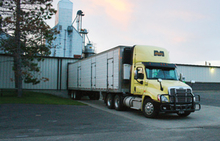Exploring new market access through Extension RSDP Backhauling Project
It was 2015 and the owners of Big Stone Garlic were unable to get their product into a wholesale market. They had to choose—let it rot or give away all the garlic they couldn’t sell.
Growers know it goes this way all too often. Local food demand is up, but the system isn’t working for them. “We see cheap and old garlic for sale in some small town stores, and it is nowhere near the quality of Minnesota-grown garlic,” says Les Olson, joint owner of Big Stone Garlic, one of the largest garlic producers in Minnesota.
Olson is a steward of the land, fulfilling his passion for family, community and sustainability in farming. Like many growers, he also works off the farm to make ends meet.
To help small- and medium-sized farmers gain access to markets, University of Minnesota Extension Regional Sustainable Development Partnerships (RSDP) is working with the University’s departments of horticultural science and applied economics to create and test a new distribution model. It’s called Farm to Rural Grocery to Wholesale, but is better known as the Backhaul Project.
The Backhaul Project connects farmers like Olson to wholesale markets through the back rooms of rural grocery stores. “When distributors make deliveries to Minnesota’s 300 grocery stores in towns with populations of less than 2,500, they could collect local farm products and bring them back on otherwise empty trucks to the warehouse for regular distribution,” says Molly Zins, executive director of RSDP’s central region.
Revitalizing rural grocery stores
Although rural grocery stores are at the heart of communities, many are closing their doors due to a shrinking customer base, competition from chain stores, and aging buildings and equipment. One aim of the Backhaul Project is to improve the viability of small town grocery stores. RSDP survey results indicated that grocers perceive fresh produce as profitable.
Bonnie Carlson owns Bonnie’s Hometown Grocery, an anchor business on Main Street in Clinton, Minn., population 450. Carlson is willing to use her store as a test site for the Backhaul Project. “I can contribute to this idea by making sure that the plan works for the small town grocery stores as well as the farmers and wholesalers,” she says.
Instead of being the passive end-point of a global food distribution system, entrepreneurs like Carlson could be the starting point of a regional system that gets locally grown foods out beyond their own towns.
“Once tested, this model has the potential for expanding beyond garlic, with replication in rural towns throughout the country,” says Zins.



